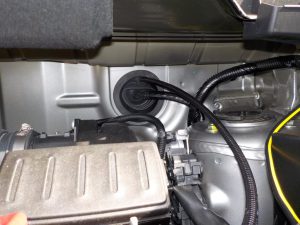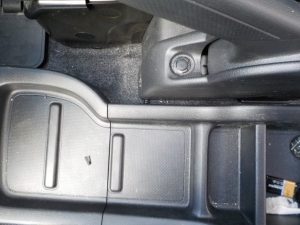There seems to be a few ideas on how to do this, and some other solutions which won’t work for me, so this was always an unknown as I’ve barely opened the bonnet on the van.
Also, we’re not currently sure how “smart” the alternator is, so we may also need to take an ignition feed off the USB socket if needed, so we won’t block this.
We’re using 10mm cable, which is overrated for the 20A we’ll draw via the ctek, but it is this size to minimise voltage drop under load. It will be fused at 25A at either end to prevent risk of damage from shorts. The wire is protected by a convoluted plastic sleeve.
On the engine bulkhead there is a massive grommet that takes some standard electrics though, and rather than drilling a new hole, I made a very tight hole in the top of this grommet, and pushed through. This comes up high in the passenger foot well, and as per the dashcam install, the cable then goes through the middle lower dash, between the seats under the centre tray, and then off under the drivers seat, under there and out the rear which is where the furniture will start.
Only 5mm of cable is visible. Cool.
I did drill a small part of the centre console for the cable to come out, but quite trivial.
In the engine, the convoluted cable is cable tied to the battery earth going to chassis for support. To prevent damage to that cable, it is wrapped in insulation tape and covered in convoluted cable.
My goal is to minimise risk of damage on the base vehicle as it does have 5 year warrantee….
Whilst not completed yet, the 10mm cable will be connected to an inline 25A fuse holder direct to battery +ve, and will be fused at 25A at the far end too.



Hi, I am trying to find a place to earth the leisure battery. They are on the exactly same position as yours. Any ideas?
Hi
Remember the entire metal chassis is at 0v – so you can earth anywhere. I planned to use the bolt from the load-tie down hook, but (FROM MEMORY) I decided to use a common earth off the CTEK D250S – as basically the engine +12v, the solar, and the mains charger all were near by, so I think I took a cable from the D250 0v and just ran that to an exiting nut that was in the recess. Sanded down the paint a little and crimped an “o” connector over the bolt. (Used 10mm cable). And the battery 0v ran up to the D250. I also took a cable to an earth block on the 12v electric control panel side and then earthed all “devices and cables” to that. Shortest route back.
Hope some of the images make sense – may be easier to look at photo gallery around the CTEK charger and the wiring. I’m away at the moment on 4g so not able to look.
Good luck
.Then
See http://www.doyourdream.co.uk/wp-content/uploads/2016/05/DSCN1618-e1464115643930.jpg for the earth block (silver thing with all the black wires). This is to earth all the switches, heater, sockets and everyting else. (I mostly ran 0v nback to here for things rather than bolting to van body)
See http://www.doyourdream.co.uk/wp-content/uploads/2016/05/DSCN1622-e1464115589811.jpg shows the black wire going the same path as the +ve – so up to the D250. Then, as mentioned, the 0v is then taken from the D250 to the van bodywork via existing bolt.
Hi Ryan. Fantastic blog am just starting an NV200 conversion using it as inspiration / guidance. Did the ctek250 need any other wiring (a D+signal) apart from the live feed from the vehicle battery to let it know when the engine was running or not?
Thanks
Mark
Hi. Nope. I have the older D250s not the D250SA which wasn’t invented when I did it. The Euro 5 I have (2016) does not have a smart alternator so isn’t an issue. If you are the same you don’t need to worry. The ignition feed is just for the smart alternator functionality (I read the manual a few days ago lol). Mine is just as per blog, + direct to vehicle battery, + to LB’s, + to Solar, and -.
Forgot to say, the Euro 6 I’ve not seen, so *may* have a smart alternator and need the D+ signal wired in. Just measure V+ after a long drive and when VB is charged and see if v>14v. If so it should be fine.
Hi!
Really great blog of your NV200 conversation! I’m currently making my own NV200 camper and here is so much inspiration.
My biggest question mark is the D250S (not SA or SE) which I got for a good price. Can you guys confirm that your setup works good and that the car has no smart alternator, or did you do any further changes?
Greetings from Sweden!
Hi, ive sold the van now. The d250s was faultless. Simple, basic, but just worked. Ours (MY16) did not have a smart alternator. The d250s was perfect size on the NV